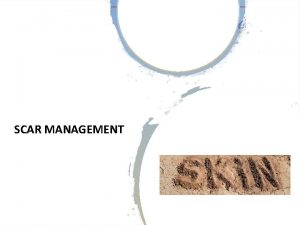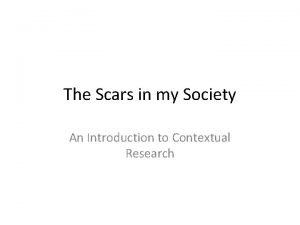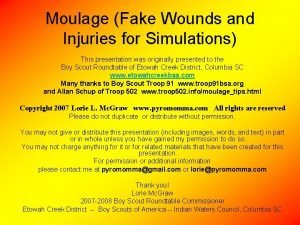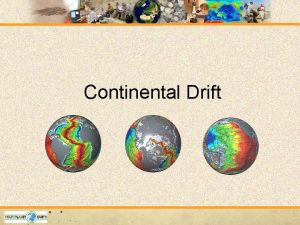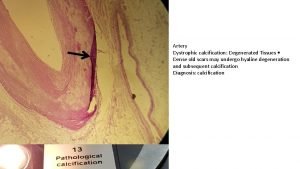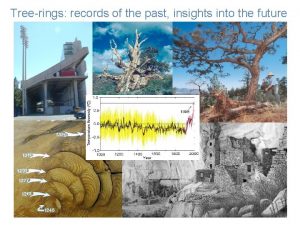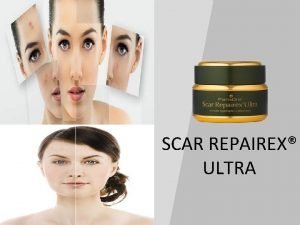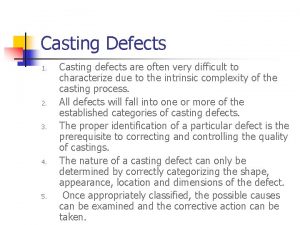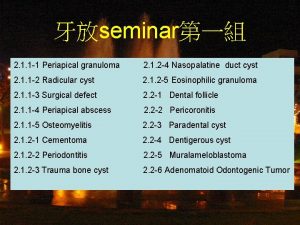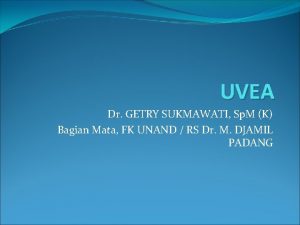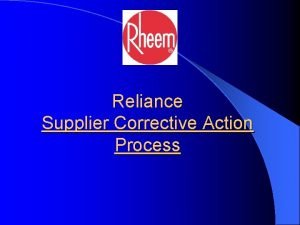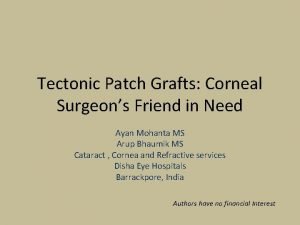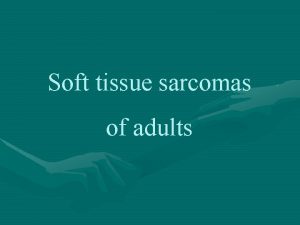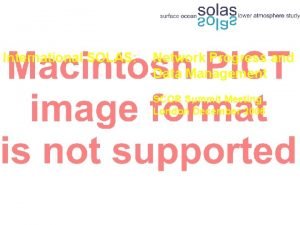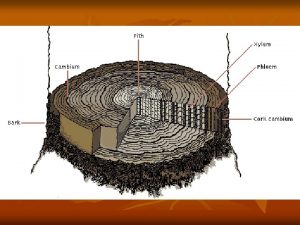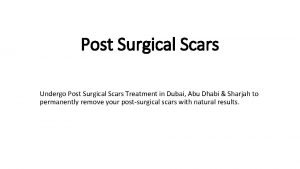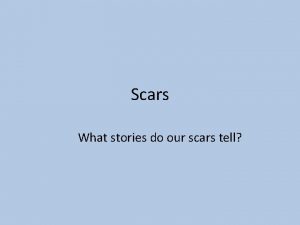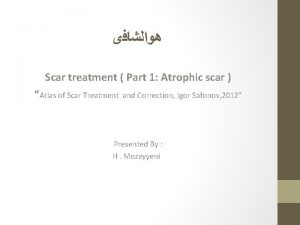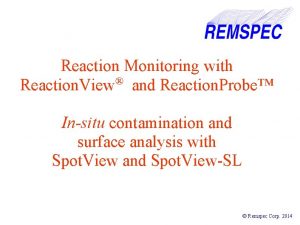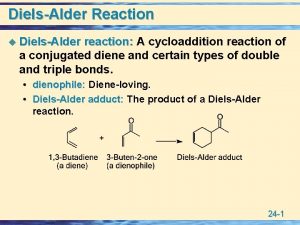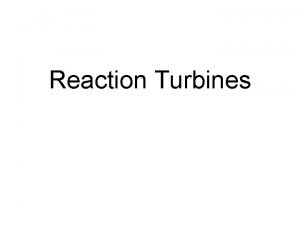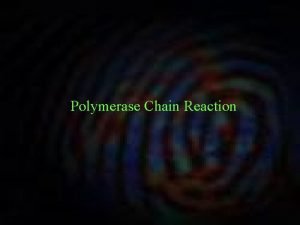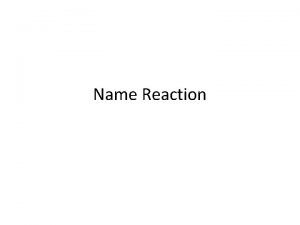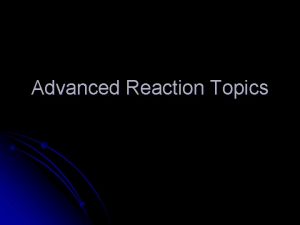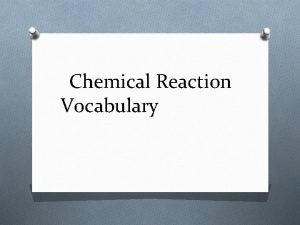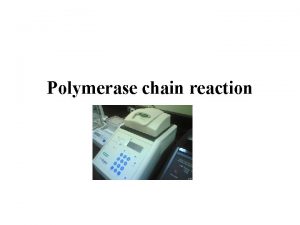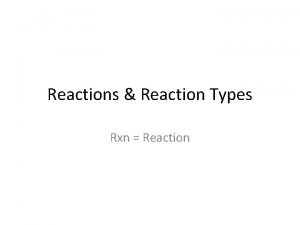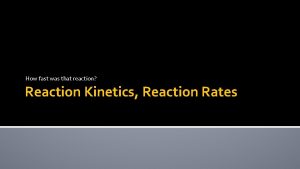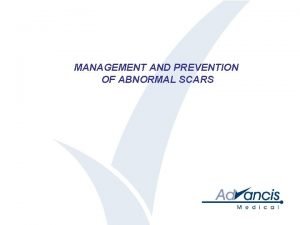SCAR MANAGEMENT How do scars form Natural reaction











































- Slides: 43

SCAR MANAGEMENT


How do scars form? Natural reaction to deep skin damage caused by: • • • Accidents Burns Surgery Grazes …

The Process of Wound Healing Phase 1 Phase 2 Phase 3 Phase 4 Haemostasis Inflammation Proliferation Maturation BUILDING THE FOUNDATION WASHING / CLEANING /BATHING BUILDING THE WALLS. 0 -5 days Macrophages engulf Leukocytes 5 -24 days Thromboplastin makes clot. Phagocytosis – “ cell eating” Releases factors for angiogenesis Immediate PUT THE ROOF ON 24 days -1 yr+ Epithelialisation – cell transfer Scar tissue is 80% of the strength of normal skin Vasoconstriction. Cytokines – protein mediator. Granulation – fibroblasts Granulation.

Scars Superficial skin damage Deep or extensive skin damage Skin normally heals itself Scar tissue • No scars • No complaints • No building blocks to repair itself (No blood vessels, hair follicle, etc) • Body forms scar tissue to close the wound

Scars and Trans Epidermal Water Loss (TEWL) Normal skin has limited TEWL Stratum Corneum Keratinocytes Epidermis Dermis Fibroblasts Collagen

TEWL Stimulates Scar Production • 1 to 2 weeks after wound closure, the skin is sealed but thin • High TEWL because of this thin skin (stratum corneum) • Stratum corneum gives a signal to the keratinocytes that there is a moisture deficit (Osmosis)

• Keratinocytes are stimulated to produce cytokines • Cytokines activate the fibroblasts to produce collagen • Excessive production of collagen provides abnormal scar tissue • It takes >1 year before the TEWL returns to normal levels

Scars • How does a scar know that it is cured?

Scars A scar can develop in three ways • Normal scar A thin scar that is barely noticable • Hypertrophic scar A thickened scar that causes symptoms • Keloid Scar An extremely thick, progressive scar that extends beyond the wound

Scars The ideal scar • • • Flat Small Colour similar to the skin Parallel with or inside a skinfold No complaints Invisible

Scars Prevalence of hypertrophic scars • 1 out of 2 operation scars become hypertrophic 1 • 2 out of 3 burn scars become hypertrophic 2 1 39% to 68% after surgery 2 33% to 91% after burns

Scars Keloid scars

Scars & evidence Treatment is focused on stopping the production of collagen Invasive • Surgery • Steroid injection • Radiation • Cryotherapy Non invasive • Pressure therapy • Silicone therapy

Scars & evidence Different scar treatments:

Scars & evidence Silicone scar treatment • Working hypothesis: - Greenhouse effect/ occlusion - Controlling the evaporation of water • Accelerates maturation of the scar Simple, safe and effective Long term treatment • •

Scientifically proven Method: • Systematic damaging of healthy skin causing increased water loss and decreased hydration • Measuring the water loss and the water content of the stratum corneum at different moments in time

Scars and TEWL • Silicone quickly repairs the barrier function of the stratum corneum • TEWL decreases • Stops signals to the keratinocytes • Cytokines are no longer produced • Fibroblasts are -activated de

Scars and TEWL • After 2 to 3 months silicone therapy, the production of collagen is normalized • No hypertrophy

Scars, & Trans Epidermal Water Loss (TEWL) Silicone, how does it work? The role of occlusion and hydration on silicone scar therapy: • Decreases TEWL = Trans. Epidermal Water Loss • Stops the production of collagen

Scars & evidence Scar management practical guidelines Importance of research : • European scar guidelines 2014 • A multi-disciplinary team 24 European experts achieved consensus of the treatment of three types of scars – hypertrophic scars – widespread scarring – keloids • Starting point was Mustoe 2002 plus the new literature up to 2011

Scars & evidence

Scars & evidence

Scars & evidence

Conclusion • 50% of all surgical interventions will result in • • abnormal scar formation Silicone therapy is the first line of therapy in international guidelines for prevention and treatment of scars Prevention is better than cure For complex scars it is better to combine therapies There is no difference in effect between a silicone dressing and a silicone gel

Conclusion • A hypertrophic scar is an over-reactive response of the body to prevent dehydration of the stratum corneum • Silicone significantly reduces TEWL causing excessive collagen production to stopped • The sooner you start with silicone products, the faster the collagen production will stop

Conclusion • Start silicone products as soon as complete wound closure • Untreated, the stratum corneum needs >1 year to recover. With a silicone treatment this will take 2 or 3 months • To prevent scars use silicone products for 2 or 3 months after wound closure or until there are no further improvements • The choice of silicone product depends upon site of scar and personal choice

Proven effect BAPSCARCARE ü Silicone is the first line of therapy & gold standard in international and European scar guidelines 1, 2 ü Actively reduces scars 1, 2 ü Scar prevention and treatment 1, 2 ü Safe and effective treatment 1 Improves scar characteristics: - Lower Height 7 + Better Elasticity 3 - Less Volume 8 - Less Hardness 4 -6 - Reduced Thickness 9 - Less Itching 8 - Less Redness 6 - Improved Colour 4, 5 + Better Blood flow 8 References: 1. Mustoe, International clinical recommendations on scar management. Plast Reconstr Surg. 2002; 110(2): 560 -571. 2. Middelkoop, Scar Management Practical Guidelines (Coordinating Editors; Esther Middelkoop, Stan Monstrey, Luc Tót en Jan-Jeroen Vrancks 3. Ahn ST, Monafo WW, Mustoe TA. Topical silicone gel: a new treatment for hypertrophic scars. Surgery 1989; 106(4): 781 -6. 4. Carney SA, Cason CG, Gowar JP, Stevenson JH, Mc. Nee J, Groves AR, et al Cica-Care sheeting in the management of hypertrophic scarring. Burns 1994; 20(2): 163 -7 5. See SM, Ngim CK, Chan YY, Ho MJ. A comparison of Sil-K and Epiderm in scar management. Burns 1996; 22(6): 483 -7 6. De Oliveira GV, Nunes TA, Magna LA, Cintra ML, Kitten GT, Zarpellon S, et al. Silicone versus non silicone gel dressings: a controlled treial. Dermatol Surg 2001; 27(8): 721 -6 7. Colom Majan JI. Evaluation of a self-adherent soft silicone dressing for the treatment of hypertrophic postoperative scars. J Wound Care 2006; 15(5): 193 -6 8. Wittenberg GP, Fabian BG, Bogomisky JL, Schultz LR, Rudner EJ, Chaffins ML, Et al. Prospective, single blind, randomized, controlled study to assess the efficacy of the 585 -nm flashlamp-pumped pulsed-dye laser and silicone gel sheeting in hypertrophic scar treatment. Archiv Dermatol 1999; 135(9): 1049 -55 9. Li-Tsang CWP, Lau JCM, Choi J, Chan CCC, Jianan L. A prospective randomized clinical trial to investigate the effect of silicone gel sheeting on post-traumatic hypertrophic scar among the Chinese population. Burns 2006; 32(6): 678 -3

Scientifically proven Is there proof of the effect? Yes, scientifically proven (2013) • Moisturizing 1 • Occlusion 1 • Long-lasting moisturizing 1 Scar management by means of occlusion and hydration: A comparative study of silicones versus hydration gel-cream. Burns. 2013 Apr 29. pii: S 0305 -4179(13)00105 -8. doi: 10. 1016/ J. burns. 201303. 025; Hoeksema H, Monstrey S, et al. Department of Plastic and Reconstructive Surgery – Burn Centre, Gent University Hospital, Belgium. 1

Scientifically proven BAP Scar. Care Offers sustained and closest to “normal” prevention of TEWL • BAPSCARCARE GEL increases the water content of the skin to an ideal level.

Case study scar

BAPSCARCARE GEL • • • Silky soft Non-greasy, non-sticky Easy to apply Quick drying – in seconds Non-shiny appearance Can be covered by make-up or camouflage

Scars need UV protection UV light dangers are increased in scar tissue • UVC: Destroys skin (Absorbed by the ozone layer) • UVB Causes sunburn, cancer, premature ageing, wrinkling • UVA Ages your skin, DNA damage, cancer • Clouds/ glass do not stop rays

What is SPF (Sun Protection Factor) number • How much protection against UVB exposure • Not related to UVA protection SPF is not linear: • SPF 2 blocks 50% • SPF 15 blocks 93% • SPF 30 blocks 97% • SPF 50 blocks 98%

What is SPF (Sun Protection Factor) number Two ways of looking at it 1. How much protection against UVB exposure 2. How long can you stay in the sun

BAPSCARCARE SPF & Guidelines 2 in 1 formula BAPSCARCARE GEL SPF ü Scar prevention and treatment ü Sun protection SPF 25 (UVA/UVB)

European guideline scars BAPSCARCARE

BAPSCARCARE When to use which product type GEL T Sheets Small scars Large scars Extended burns Personal preference Old and new scars Face, neck visible skin area Every location on the body Under clothing, combination pressure therapy Sensitive skin Locations where Thick, is more comfortable adhesive force is needed Special shapes

Extended Product List Beyond the Formulary

BAPSCARCARE

BAPSCARCARE S • • • Transparent and self-adherent 1. 2 mm thick Reusable and washable For larger scars Pre-shaped sizes Ideal for use with pressure garments

BAPSCARCARE T • • • Self adhesive easy to use Does not need to be washed during use 0. 3 mm thick, almost invisible Stays in place for up to 7 days Conforms to body contours Flexible

For more information contact us on 01462 346100 Or email info@esperehealth. co. uk www. esperehealth. co. uk
 How do scars form
How do scars form Scars in society art
Scars in society art Plexr acne
Plexr acne How to make fake skin with vaseline and cornstarch
How to make fake skin with vaseline and cornstarch Abdominal scars osce
Abdominal scars osce Similar fossils found on different continents
Similar fossils found on different continents Midterm break theme
Midterm break theme Dense old scars
Dense old scars Tree ring fire scar
Tree ring fire scar The joy luck club questions
The joy luck club questions Steve wallis scar
Steve wallis scar Sandblast scar map
Sandblast scar map Mock hunt lord of the flies
Mock hunt lord of the flies Cuts and washes defects in casting
Cuts and washes defects in casting Oxbow scar
Oxbow scar Hast thou no scar
Hast thou no scar Samneric lord of the flies
Samneric lord of the flies Hercules scar rug
Hercules scar rug Lateral periodontal cyst
Lateral periodontal cyst James ward gordale scar
James ward gordale scar Aqueous flare
Aqueous flare What are the seven characters used for encounter types
What are the seven characters used for encounter types Supplier corrective action
Supplier corrective action Scar booth
Scar booth Opposite leaf arrangement
Opposite leaf arrangement William shakespeare lion king
William shakespeare lion king Eye scar
Eye scar Thigh sarcoma
Thigh sarcoma Scar forest
Scar forest Bilateral incision
Bilateral incision Carpal tunnel release scar
Carpal tunnel release scar Solas scar
Solas scar Scar bg
Scar bg Rate of reaction
Rate of reaction Ictahedron
Ictahedron Leukoerythroblastic reaction vs leukemoid reaction
Leukoerythroblastic reaction vs leukemoid reaction Neutron emission
Neutron emission Interrogative form present continuous
Interrogative form present continuous Natural hazards vs natural disasters
Natural hazards vs natural disasters Natural capital and natural income
Natural capital and natural income Top management and middle management
Top management and middle management Management pyramid
Management pyramid Basic concepts of management
Basic concepts of management Log and exponential form
Log and exponential form
